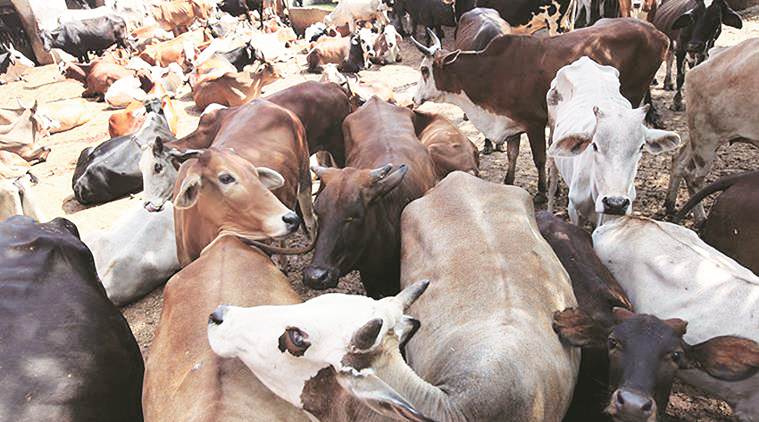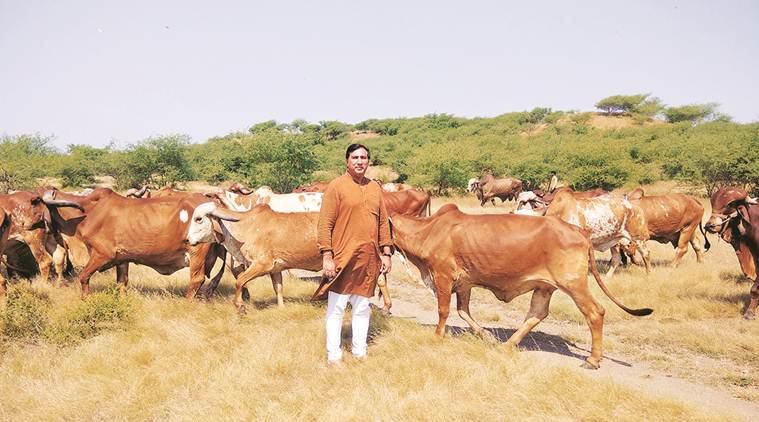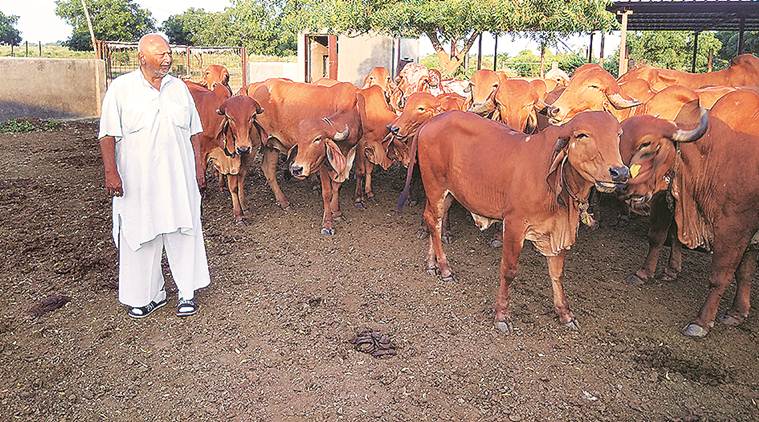
With the Centre deciding to import the semen of Gir bulls from Brazil in its attempt to promote indigenous varieties of cows in the country, cattle breeders Shivraj Khachar and Ghanshyamji Vyas, who are known for preserving the Gir breed of cows in the state, have led the protests against the government’s move.
Earlier this year, the government had floated tenders to import one lakh doses of frozen semen of progeny tested Gir bull from Brazil for artificial insemination. With farmers in India preferring high milk-yielding breeds such as the Jersey, over time, indigenous varieties of cattle have witnessed a steady decline.
The government zeroed in on Brazil’s Gir variety since the breed has its origin in India — the bulls are believed to be the progeny of Gir cows imported from India, including Krishna, a bull gifted by the royal family of erstwhile princely state of Bhavnagar to Brazil in the 20th Century.
Khachar and Vyas claim the Brazilian Gir cows are not pure breed and say the government’s decision will end up destroying the pure Gir breed native to India. They have found support from RSS chief Mohan Bhagwat, who, during his Vijayadashmi address, questioned, “Why are we asking Brazil for semen for cows when India has its own cows?”

Satyaji Khachar, 58
The patriarch of the royal family of erstwhile princely state of Jasdan in present-day Rajkot district, Khachar says his family has been rearing Gir cows since the 17th Century.
Khachar, who owns 160 acres of agricultural land and around 186 acres of ‘vidi’ or privately owned pastoral land, rears around 150 cows and four bulls of the Gir breed.
Khachar, who holds degrees in marketing and economics, says it’s important to preserve native breeds. “During my student days, the debate on cross-breeding was raging. The thrust of the White Revolution was on increasing milk production. But of late, milk productivity of cross-bred cows has stagnated and there is a renewed interest in native pure breeds,” says Khachar.
Foreign exotic breeds such as Holstein Friesian and Jersey, which produce up to three times more milk compared to the indigenous breeds, were introduced in India during the White Revolution of the 1960s and 1970s.
“I have continued the family tradition of cow breeding with the twin objectives of improving the Gir breed and to develop a sustainable model of dairy farming that can be replicated by dairy farmers,” says Khachar, adding his cows yield an average of 3,700 kilogrammes of milk per lactation of around 300 days.
Going beyond traditional milk sale and selling heifers and bulls, Khachar set up a company in Brazil in 2011 and exported around 600 Gir cow embryos to that company. The same year, he set up a partnership firm called Gokripa Products in Jasdan which manufactures panchgavya (milk,yogurt, ghee, cow dung and cow urine) products. The firm started out by selling cow urine extract. “I realised I was not getting the true value of by-products.”
Today, Kachar processes the entire quantity of around 400 litres of milk his herd yields daily and also procures around 3,500 litres from 10 gaushalas that rear Gir cows. “Gir cow products are richer compared to other varieties. Gir cows produce A2 type milk and our milk powder plant is the only one in India which manufactures A2 milk powder,” he says. A2 is a protein in milk, which, activists and breeders claim, is more beneficial for human consumption.
On the proposed import of Gir bull semen doses from Brazil, he says, “My fear is that the Brazilian Gir cows, which have been cross-bred with other breeds, won’t be able to survive here. They won’t be able to survive the heat here. That will eventually harm our native breed,” says Khachar, whose cows have won nine national awards for highest milk production in a day.

Ghanshyamji Vyas, 77
Vyas is chief of Bhuvaneshwari Pith, a religious institute, which, besides offering ayurveda services (Vyas himself is honourary consultant to Gujarat governor. They also manufacture ayurveda products but not panchgavya) also breeds Gir cows. The Pith has been rearing Gir cows since 1910 and Vyas has been involved in it for the past 50 years. The Pith owns 50 acres of grazing land near Gondal town and some agricultural land in Surat.
Today, Bhuvaneshwari Pith Gaushala has a herd of 200 cattle heads, which includes four bulls and around two dozen male calves. Vyas says his herd produces around 200 litres daily. The Pith sells this milk locally and in Rajkot city at Rs 55 per litre. His cows yield an average 3,000 kg of milk per lactation cycle, he says.
He, however, says the sale of milk does not cover the monthly maintenance cost of around Rs 4.5 lakh, spent mostly on feed and wages of employees. “Cow breeding is different from running a gaushala or a panjrapol (where diseased and disabled animals are also sheltered). Our objective is to maintain a gene pool of highly productive Gir cows, not to make profit out of dairying,” says Vyas.
The Pith sells around 25 male calves every year at a price of Rs 25,000 to Rs 1.25 lakh each and around 25 cows in the price range of Rs 1 lakh to Rs 3 lakh to make for the losses.
Vyas, who is also a member of National Livestock Mission of the Central government, says the proposed import of semen doses from Brazil will impact the Indian livestock. “Our cows weigh an average of 400 to 500 kg whereas the Brazilian Gir bulls weigh around 1,200 kg each. Our cows, impregnated from the semen of the Brazilian bulls, may have trouble delivering calves. Also, what do we do with our bulls and male calves once the imported doses are here?
The problem of feral cattle will worsen,” says Vyas.
Vyas also says the fodder-to-milk-production ratio of Indo-Brazilian Gir cows doesn’t suit Indian conditions. “In Brazil, 25 cows graze on about 500 acres whereas our Gir cows have adapted to stall-feeding. Our cows develop their bodies primarily to produce milk and can even survive droughts whereas Gir cows in Brazil were cross-bred with other breeds to primarily produce meat. How much fodder can our dairy farmers afford to offer their cows?” asks Vyas.